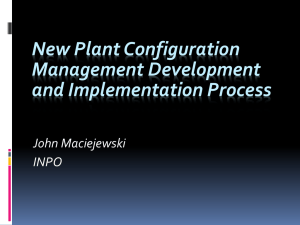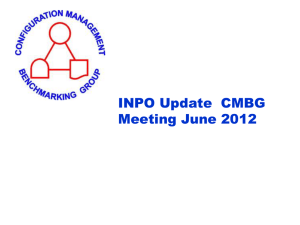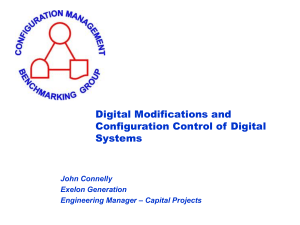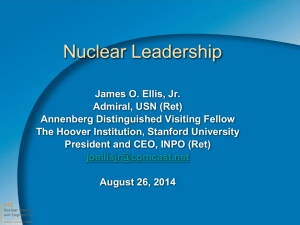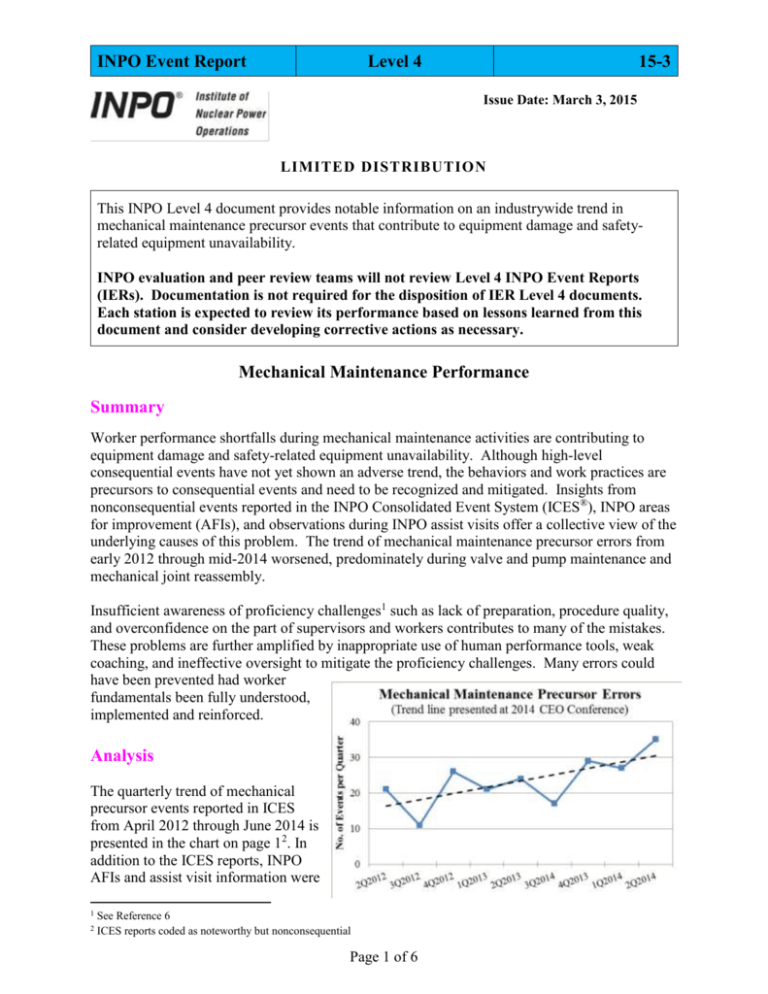
INPO Event Report
Level 4
15-3
Issue Date: March 3, 2015
LIMITED DISTRIBUTION
This INPO Level 4 document provides notable information on an industrywide trend in
mechanical maintenance precursor events that contribute to equipment damage and safetyrelated equipment unavailability.
INPO evaluation and peer review teams will not review Level 4 INPO Event Reports
(IERs). Documentation is not required for the disposition of IER Level 4 documents.
Each station is expected to review its performance based on lessons learned from this
document and consider developing corrective actions as necessary.
Mechanical Maintenance Performance
Summary
Worker performance shortfalls during mechanical maintenance activities are contributing to
equipment damage and safety-related equipment unavailability. Although high-level
consequential events have not yet shown an adverse trend, the behaviors and work practices are
precursors to consequential events and need to be recognized and mitigated. Insights from
nonconsequential events reported in the INPO Consolidated Event System (ICES®), INPO areas
for improvement (AFIs), and observations during INPO assist visits offer a collective view of the
underlying causes of this problem. The trend of mechanical maintenance precursor errors from
early 2012 through mid-2014 worsened, predominately during valve and pump maintenance and
mechanical joint reassembly.
Insufficient awareness of proficiency challenges1 such as lack of preparation, procedure quality,
and overconfidence on the part of supervisors and workers contributes to many of the mistakes.
These problems are further amplified by inappropriate use of human performance tools, weak
coaching, and ineffective oversight to mitigate the proficiency challenges. Many errors could
have been prevented had worker
fundamentals been fully understood,
implemented and reinforced.
Analysis
The quarterly trend of mechanical
precursor events reported in ICES
from April 2012 through June 2014 is
presented in the chart on page 12. In
addition to the ICES reports, INPO
AFIs and assist visit information were
1
2
See Reference 6
ICES reports coded as noteworthy but nonconsequential
Page 1 of 6
INPO Event Report
Level 4
15-3
reviewed to obtain further insights regarding underlying causes. The collective review identified
three primary underlying causes of mechanical-maintenance-related precursor events as follows:
Workers did not fully understand and apply appropriate fundamentals and standards,
which led to inconsistent work quality. The fundamental that is most often overlooked is
whether workers are prepared to perform high-quality corrective and preventive
maintenance.
Supervisors and workers did not understand and account for the risk significance of the
work activity during work planning, assignment and execution. In most cases, had the
importance of the component or system to reactor safety and station reliability been
understood, additional measures would have been taken to provide and ensure highquality work.
Inadequate preparation because of late work assignments challenges the depth of
procedure and documentation review and exacerbates time pressures, whether selfimposed or schedule driven.
To obtain perspective regarding frequency of these causes, each ICES report was assigned the
best-fitting underlying cause, resulting in the following bar graph.
Nearly half of the events and
many AFIs reveal a
weakness in the application
of maintenance fundamentals
and standards. In several
cases, mechanical
maintenance supervisors did
not provide coaching and
reinforcement of
maintenance fundamentals
and standards, which are
vital to reducing maintenance
errors.
In other cases, maintenance
supervisors and workers did
not recognize the risk significance or potential plant impact of performing maintenance
incorrectly. Several events were the result of latent equipment failures not revealed during
postmaintenance testing that were caused by improper reassembly of critical and safety-related
equipment. These events resulted in a perception that associated risks were low during these
work activities. Subsequently, prejob briefings and job site reviews inadequately addressed risks
identified in the work plan, contributing to the continuation of worker errors.
In some cases, workers did not have an opportunity or sufficient time to review the work task
before execution, limiting their effectiveness in identifying weaknesses in work instruction
technical details or errors in the work instructions. An analysis of industry scrams3 noted that
3
See Reference 3
Page 2 of 6
INPO Event Report
Level 4
15-3
over half of maintenance-related scrams involved insufficient maintenance work instruction
detail. Assigning work late prevents adequate review and understanding of the work task by
workers and supervisors.
Lastly, supervisors and workers are not recognizing circumstances that can challenge the
performance of even the most proficient workers; consequently, they do not establish controls to
mitigate those challenges. For example, a main steam isolation valve was reassembled
incorrectly, resulting in a forced outage extension. The error was partly caused by the work
being reassigned from a specialized vendor to in-house mechanics. Even though the in-house
mechanics had not performed this task before and were unfamiliar with the reassembly of the
valve, the supervisor did not recognize and assess the proficiency challenges nor take the
necessary actions to mitigate the errors.
Lessons Learned
Mechanical maintenance staff must understand and apply appropriate fundamentals and
standards for ensuring consistently high-quality work. Supervisors should communicate and
reinforce maintenance fundamentals during maintenance training, prejob briefings, and
oversight of field activities. INPO 15-001, Nuclear Maintenance Fundamentals, can be used
to improve the understanding of maintenance fundamentals of workers, supervisors and
maintenance managers.
Supervisors and workers should understand all risks associated with a maintenance activity
so that actions can be identified and taken to mitigate the risks. Review the guidelines in
INPO 05-004, Guidelines for the Conduct of Maintenance at Nuclear Power Stations, for
using a graded approach to work planning commensurate with the level of task risk.
Ensure work packages are assigned to workers far enough in advance of the scheduled start
date to allow adequate review, understanding and clarification. Work should not be assigned
on the morning of execution — this being the first opportunity for workers to prepare for the
activity.
Supervisors and workers should recognize proficiency challenges and take appropriate
mitigating actions when work is being prepared, assigned and executed. Ensure supervisors
understand the concepts of proficiency challenges and appropriately evaluate them when
assigning and overseeing work.
Consider using Attachment 1 to evaluate shortfalls in mechanical maintenance training based
on observed behaviors.
Attachments
Attachment 1: Mechanical Maintenance Behaviors Observed During INPO Evaluations and
Assist Visits
References
1. INPO 15-001, Nuclear Maintenance Fundamentals
2. INPO 05-004, Guidelines for the Conduct of Maintenance at Nuclear Power Stations
Page 3 of 6
INPO Event Report
3.
4.
5.
6.
Level 4
15-3
IER L2-11-2, 2009-2010 Scram Analysis
IER L4-12-82, Emergency Diesel Generator Leaks
IER L4-14-30, Analysis of Vibration-Induced Piping and Tubing Leaks (2010 through 2013)
INPO Member Website (Proficiency), Advancing Proficiency (Brochure)
Page 4 of 6
INPO Event Report
Level 4
15-3
Attachment 1
Mechanical Maintenance Behaviors Observed During INPO Evaluations and Assist Visits
–
When performing a crisscross final torque of flow orifice flange bolts, a supplemental mechanic
lost position on the flange. This resulted in re-torqueing two bolts and not applying the final torque
on another two bolts. (maintenance fundamental)
–
Supplemental valve technicians did not stop when unsure and question unexpected conditions
when installing the air-operated valve (AOV) actuator into the valve bonnet. When the workers
attempted to install the actuator into the bonnet, the actuator stem bottomed out before the actuator
was fully inserted into the bonnet. Three additional attempts were made to insert the actuator into
the valve bonnet, resulting in multiple contacts between the stem and bonnet. (maintenance
fundamentals)
–
A mechanic's glove smeared a valve disc when installing the valve disc assembly into the valve
body during performance of the diesel jockey pump check valve seat blue check. Smearing can
result in a false indication of a seat and disc inspection if the blue check die is rubbed off during the
installation. (maintenance fundamentals)
–
Mechanics did not secure fasteners, match mark components or label parts during disassembly of a
vault vapor extractor fan. (maintenance fundamentals)
–
A mechanic inappropriately used a flat screwdriver and a ballpeen hammer to remove a
used spiral-wound gasket from a tongue-and-groove flange joint connecting a main steam relief
valve to piping. (maintenance fundamentals)
–
Mechanics working on an AOV inappropriately used a brass bar as a hammer, a Phillips
screwdriver to apply lubrication, and a screwdriver to align the upper and lower air dome holes
with the diaphragm. (maintenance fundamentals)
–
A mechanic improperly set up the test equipment before performing the auxiliary feedwater pump
turbine oil cooler pressure test. This resulted in erroneous readings that the test was acceptable
when in fact the test criteria had not been met. The work order step required a leak test of the lube
oil cooler with air set to 50 pounds per square inch (psi) for 10 minutes. The test equipment setup
was an air cylinder and a regulator set at 50 psi connected directly to the oil cooler. This setup
would maintain the air pressure at 50 psi until the air cylinder emptied. (work practices)
–
A mechanical supervisor did not verify the required position of a hydraulic control unit valve
before incorrectly directing the valve to be positioned to the as-found position. (work practices)
–
A mechanic used an inadequate work order to perform sealant stick leak repair for the auxiliary
feedwater inlet valve body. (work practices)
–
Supplemental valve technicians did not follow work instructions and improperly tightened the
actuator for a moisture separator reheater drain tank level control valve. (work practices)
–
While replacing and charging suction stabilizer and discharge pulsation damper bladders on a
positive displacement charging pump, a mechanic did not perform a prescribed procedure step
without concurrence from supervisors. (work practices)
Page 5 of 6
INPO Event Report
Level 4
15-3
LIMITED DISTRIBUTION: Copyright © 2015 by the Institute of Nuclear Power Operations. Not for sale or for commercial use.
Unauthorized reproduction is a violation of INPO policy and U.S. and international copyright laws. The confidential, proprietary
information herein is for use only by members and participants of INPO. This material is not authorized to be transferred or
delivered to any third party, and its contents must not be made public, without INPO’s prior written consent. All other rights
reserved.
NOTICE: This information was prepared in connection with work sponsored by the Institute of Nuclear Power Operations (INPO).
Neither INPO, INPO members, INPO participants, nor any person acting on behalf of them (a) makes any warranty or
representation, expressed or implied, with respect to the accuracy, completeness, or usefulness of the information contained in this
document, or that the use of any information, apparatus, method, or process disclosed in this document may not infringe on privately
owned rights, or (b) assumes any liabilities with respect to the use of, or for damages resulting from the use of any information,
apparatus, method, or process disclosed in this document.
Page 6 of 6

